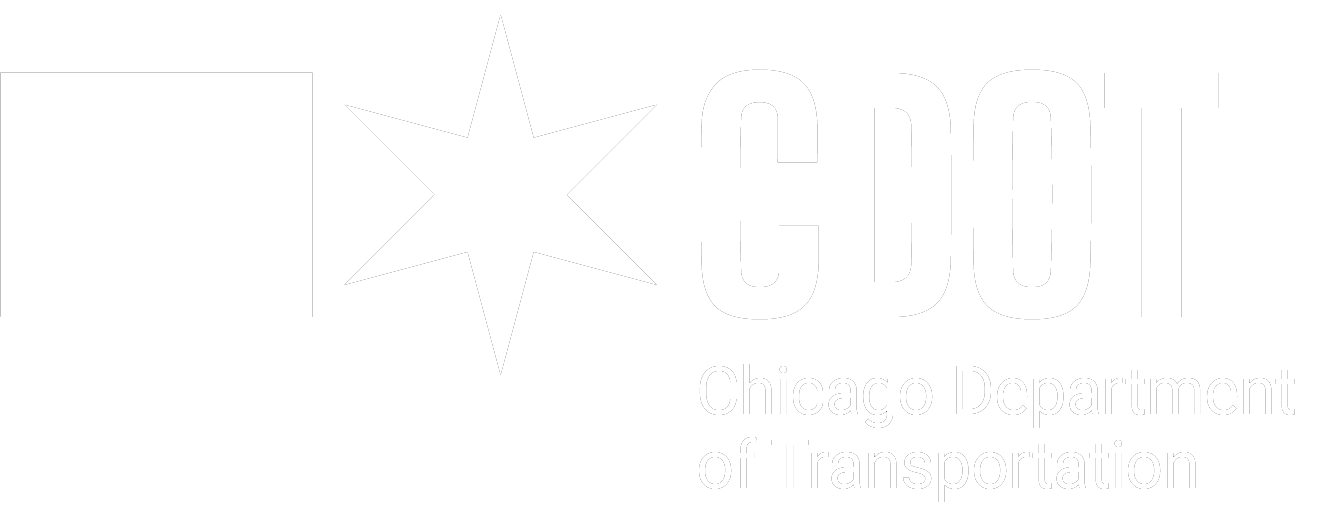
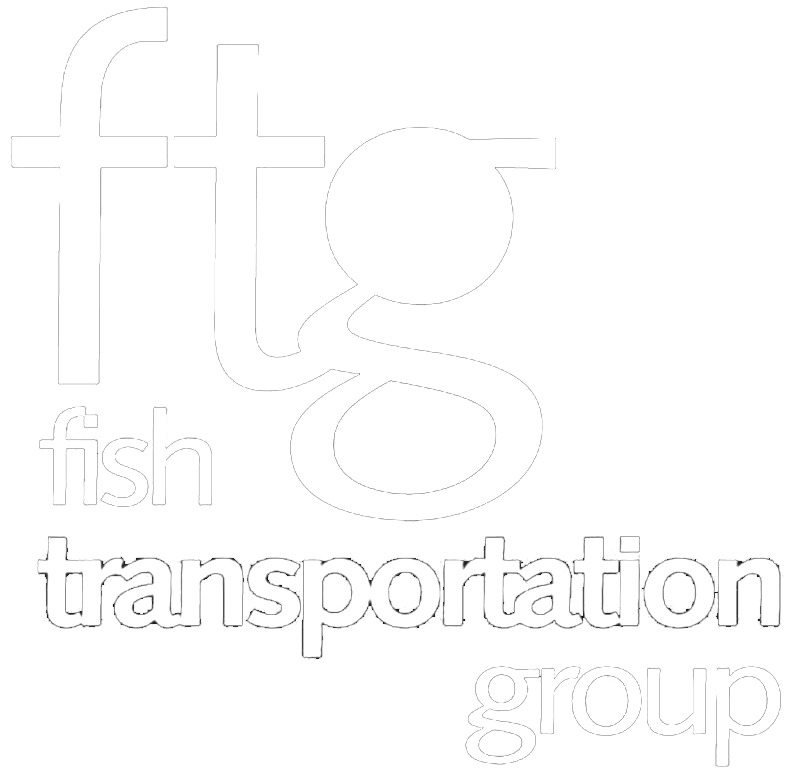

Purpose
Collecting truck traffic data is vital. It shows the issue through hard numbers. These counts are most powerful when echoing lived experiences.
The data supports the many years of community advocacy and community testimony. We hope that learning more and more about the effects of heavy diesel emissions can lead to changes such as 'zero-emission technologies' that can better our built environment.
Jocelyn Vazquez-Gomez, Community Science Organizer, LVEJO

Existing truck counts for commercial and industrial vehicles are not easy to attain. Some traffic sources, while thorough, miss collecting data on important neighborhood streets of concern. Other sources show approximations or may not separate trucks from the rest of the flow of traffic. For many, existing traffic studies may need to be requested. Yet these studies may only show traffic at certain peak hours instead of a full day.
This project is a step towards fulfilling the need for accessible, community-level truck traffic in Chicagoland. Our truck counts are designed to be accessible for policymakers, community leaders, and the public. These counts are not estimates, but real numbers.
We hope this new truck count portal contributes to the growing consensus that we must find solutions to toxic truck emissions, especially in communities facing many environmental and social injustices.
Trucks are large vehicles that drive every day on our city’s roads. Most trucks rely on diesel, biofuels, or a mix of both for fuel, all of which cause air pollution. These vehicles are designed for transporting goods, also known as freight, and typically have a space at its rear dedicated to moving goods. Trucks come in all sorts of sizes and arrangements. Glance below to see what trucks look like and how they’re categorized by the U.S. Department of Transportation Federal Highway Administration:

Source: Federal Highway Administration
Trucks are officially classified into different classes along with all other vehicles on the road. Truck classes are based on the total weight of the truck and the number of axles. See our Methodology Notes section for details on the truck classes sorted through this project.
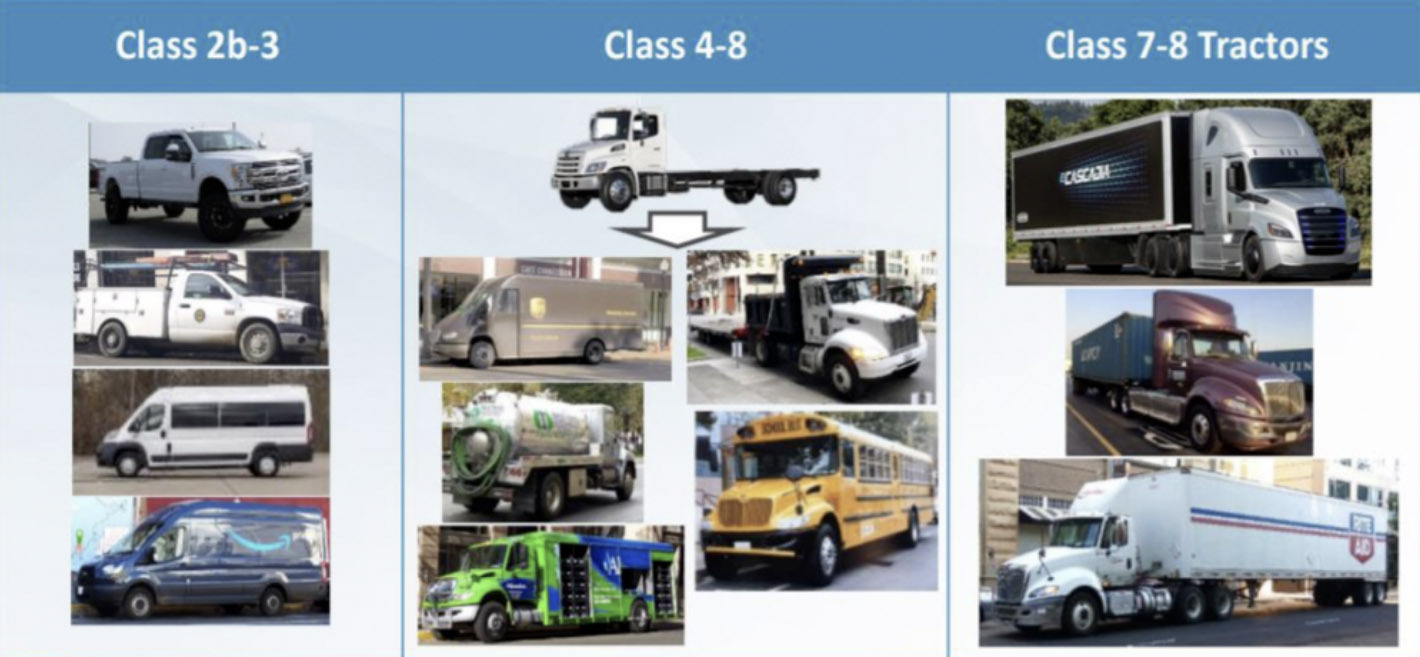
Source: Neighbors for an Equitable Transition to Zero-Emission
Pictured are light-duty trucks (Classes 2b and 3), buses and medium-duty trucks (Classes 4 - 8), and heavy-duty trucks (Classes 7 and 8).
Chicago plays a crucial role in the movement of goods. As an inland port city, Chicago is the largest intermodal shipping center in the United States with up to $3 trillion in goods moving through the Northeastern Illinois region every year. Shipping and distribution centers, warehouses, rail yards, and all other freight facilities operating in the region attract commercial and industrial trucks by design. Chicago is home to all 6 Class I railroads– the only location in the Western hemisphere where they all converge, making it a premier rail hub. There are 19 intermodal rail yards, by far the most in the country, and about 25% of all freight trains and 50% of all intermodal trains in the U.S. pass through the city. All truck-attracting industrial areas in metropolitan Chicago add to about 1.1 billion ft2 – equivalent to about 17,400 football fields. (CMAP, On To 2050).
Intermodal rail yards and other truck terminals have a significant toll on local public health and quality of life. Anyone regardless of race or class can experience negative effects from tailpipe pollution. Yet, many truck-intensive facilities are in low-income areas and communities of color who are also exposed to additional environmental pollutants. When rail yards transfer goods to trucks, the trucks frequently drive next to homes, schools, and places of work and play. On urban interstate highways alone, trucks account for about 1 in 7 vehicles, with some highways in Chicago carrying over 30,000 trucks each day. High amounts of traffic from diesel trucks has been a concern for workers and communities in Chicago’s industrial corridors for decades, especially in Chicago’s southeast and southwest sides which have by far the largest industrial corridors in the city.
Diesel trucks are only 7% of traffic on Illinois’ roads but account for 36% of greenhouse gases, 59% of particulate matter (PM 2.5), and 67% of smog-forming nitrogen oxides emitted by all on-road vehicles (NRDC).Greenhouse gases like carbon dioxide are a cause of the climate crisis, and air pollutants like soot and nitrogen oxides are directly linked to increases in health risks and disparities.
Diesel exhaust from trucks is a hazardous pollution source, up to 100 times more toxic than gasoline exhaust. Chemicals and particles in diesel exhaust can irritate the skin, eyes, the lower and upper respiratory tracts, and trigger headaches, lightheadedness, fatigue, confusion, and asthma. This tailpipe pollution even contains over 40 known carcinogens that can lead to lung cancer. Diesel exhaust provokes fatal and non-fatal heart attacks, strokes, irregular heartbeats, and may cause premature death in people with pre-existing heart and lung diseases. Illinois alone ranks 5th among all 50 U.S states with the highest death toll per capita from diesel engine PM 2.5 emissions.
Particulate matter size compared to sand and human hair:
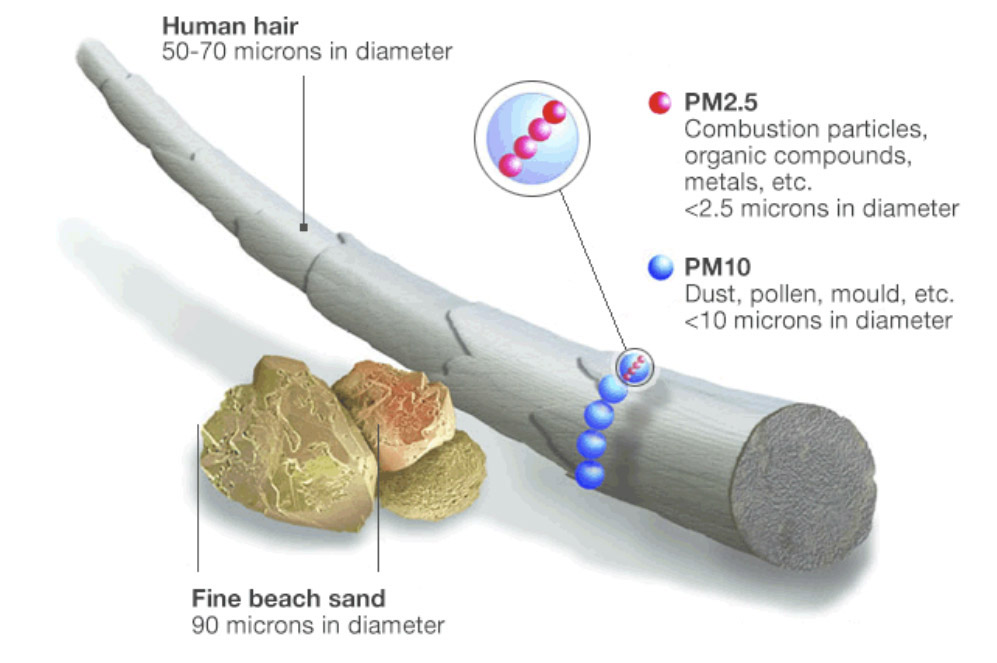
Source: U.S. Environmental Protection Agency
This is a regional environmental justice issue. Low-income neighborhoods and communities of color are exposed to more of this pollution– an average of 28% more nitrogen dioxide (NO2), for example– because industrial and truck-intensive facilities, rail yards, and highways are often located in these areas. Institutionally racist practices like redlining and inner-city highway expansion historically facilitated these disparities. These communities often shoulder not only substantial diesel truck pollution and physical safety concerns from truck congestion but also emissions from all other nearby polluting facilities.
In other words, these community areas are treated like sacrifice zones for economic development as they are on the frontlines of receiving overlaying human-caused sources of pollution over time. These neighborhoods have been colloquially considered environmental justice communities for decades, but as of September 2023, the City of Chicago has officially designated certain areas as environmental justice communities through their EJ Index. Many like Englewood, Lower West Side, McKinley Park, New City, South Deering, and South Lawndale were locations for at least one 24-hour truck count. While a problem to be overcome in Chicago’s community areas, multi-source industrial pollution afflicts northeastern Illinois at large. All seven counties in the region are within the top 9% of all counties nationwide whose residents are at risk of health, societal, and economic impacts from diesel exhausts' fine particulate matter.
There’s an urgency to address heavy-duty truck pollution because it’s diminishing the quality of lives and communities that are suffering the most from it. You simply cannot wait on asthma. It’s so disruptive to your day-to-day life and causes so much anxiety because you never know; is this going to be the asthma attack I don’t wake up from?
Tonyisha Harris, South Shore Chicago native, Youth climate and environmental justice activist

These overlaying sources of pollution and the health harms it causes over time are known as cumulative impacts. In response to environmental justice advocates calling for cumulative impacts to be a priority consideration for assessing permits for new developments and for expanding industrial uses, the City of Chicago conducted its first-ever Cumulative Impact Assessment between May 2022 and August 2023. Generally, cumulative impact analysis of all kinds evaluates many environmental and sociodemographic factors. Research shows that the same environmental exposure is more likely to harm the health of populations with certain factors of vulnerability, like young age, old age, or asthmatic people.
See the cumulative impacts scores in this portal’s Camera Locations map for a freight-focused cumulative impacts analysis. Other versions of cumulative impacts analysis for Chicago include the Natural Resource Defense Council’s 2019 Cumulative Environmental & Socio-Demographic Burden map and the Chicago Department of Public Health’s 2020 version focusing on different air quality pollutants, aptly named the Air Quality and Health Index.
Traffic cameras were deployed at 35 locations in 17 Chicago community areas and 1 Cicero location, recording over 800 video hours of trucks and buses. This video showcases a sample of camera recordings from each location from April 2023 to September 2023.
Video sample: Compilation of 24-hr traffic count videos
Privacy: Miovision traffic cameras efficiently track vehicle and pedestrian movements over brief time periods only. They use a low video resolution to prevent the recognition of faces and license plates and do not record sound.
This truck traffic data collection project was primarily funded to collect data, rather than to rigorously analyze it. This project does not inform where or to whom the trucks are registered, although some of our cameras were strategically placed in proximity to the driveways of known truck-generators. Our data also cannot distinguish diesel-powered trucks from electric models, but as said in a 2023 Crain’s Chicago Business article, less than 1% of medium and heavy-duty trucks on the road are electric.
These counts reflect Average Daily Traffic (ADT), the standard measure of traffic volume commonly used for traffic analysis. By applying seasonal factors these numbers can also be converted into AADT (Average Annual Daily Traffic) to represent the average truck volumes over an entire year.
Given the differences of the truck counts from intersection to intersection even within the same neighborhood area, we do not advise extrapolating this data to larger geographic areas.
Data was collected in 17 Chicago community areas and one in Cicero, representing a snapshot in time from April 2023 to September 2023. The data shows exactly how many trucks passed through each intersection, mid-block, or driveway location over 24 hours on a typical non-holiday weekday (Tuesdays).
The downloadable truck counts on this portal showcase trucks from Class 4 to Class 13. The reports show ‘Bicycles on Road’, ‘Bicycles on Crosswalk’, ‘Pedestrians’, ‘Lights’, ‘Single-Unit Trucks’, ‘Buses’, ‘Buses and Single-Unit Trucks’*, and ‘Articulated Trucks’. Single-unit vehicles, from delivery vans to school buses, are made of one continuous unit and are considered medium-duty. Articulated trucks are made of two separate but connected units, the tractor and tailor, and are considered heavy-duty. The ‘Single-Unit Trucks’, ‘Buses’, ‘Buses and Single-Unit Trucks’, and ‘Articulated Trucks’ categories used by Miovison are what comprise the counts presented on this portal.
- Light-duty vehicle classes: 1 - 3
- Bus classes: 4
- Single-unit (medium-duty) truck classes: 5 - 7
- Articulated (heavy-duty) truck classes: 8 - 13
Some light goods truck like pickups and vans (Class 2b and Class 3) were automatically grouped into ‘Lights’ by Miovision, the same category as cars and motorbikes. See Miovision’s Vehicle Classification guide for more information.
*Due to initial processing, 21 out of 35 locations combine rather than distinguish single-unit trucks from buses. Regardless, trucks and buses that run on dirty fuels significantly contribute to air pollution.
Miovision is the hardware and software used to collect and extract the truck volume data. The technology used to collect traffic volumes is the portable, video-based unit Miovision Scout™, a device comprised of a control box, pole mount, and a camera. Fish Transportation Group, Inc. (FTG) deployed units at 35 selected roadsides which were directly mounted to a post like a light pole, traffic signal mast, or roadway sign pole. The camera on top of the pole mount recorded an unobstructed view of the road (including intersections, turn lanes, bike lanes, or pedestrian crosswalks). Some roadway locations like large intersections required more than one camera.
After the 24-hour count period, the portable Miovision Scout™ unit was removed and the video (stored on an SD card in the control box) was uploaded to Miovision for data extraction and processing. Miovision asserts that “once a video is uploaded to Miovision, it’s configured by a Data Services Technician to identify vehicle entry and exit points, and all possible movements. The data is then manually reviewed for accuracy and anomalies. Corridors and adjacent locations are checked with data visualization tools to ensure a ±5 vehicle accuracy or 95% match between common links. Miovision ensures 95%+ data accuracy on most multidirectional counts”.
Once completed, the processed video and extracted data were available exclusively to our team through the online Miovision DataLink™ platform. This portal presents this data– scroll down to the Reports & Data Snapshots section to see or download Miovision’s spreadsheet and PDF data reports.
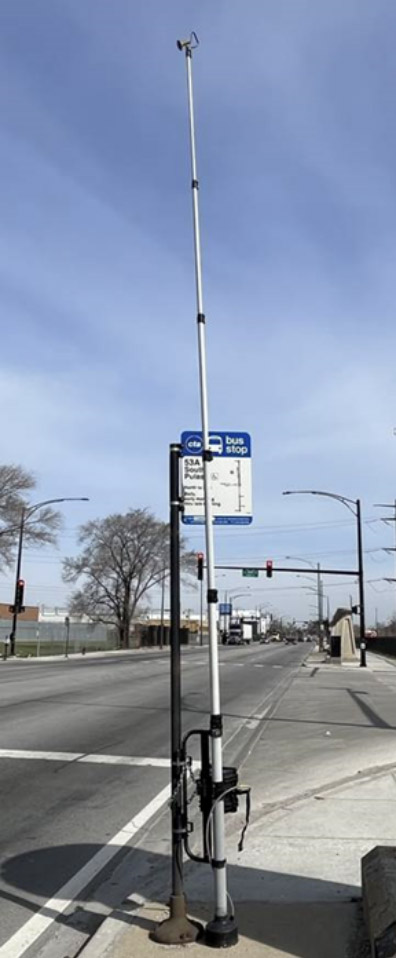
Miovision Scout™ camera, control box, and pole mount

Camera Locations
There are 35 locations where trucks & buses were counted. Zoom in and click on the circles to learn more details about the site.
1,000 - 5,000 trucks & buses /day
Quantile Score for Demographics, Environment, Health, and Trucking
1 2 3 4 5
This color-coded map shows cumulative impacts from freight and logistics. Meaning, it analyzes the compound effects of pollution from multiple sources, resident health ailments, logistics hub locations1, and truck traffic variables2. All these factors are measured relative to marginalized population3. The highest ratio scoring 5 signifies areas with the highest freight-focused cumulative burden faced by Census block groups with marginalized demographics. The lowest ratio scoring 1 shows areas with the least cumulative burden and less marginalized demographics. This map was developed by CNT through the Delivering Zero Emissions Communities program.
Disclaimer: Some of these scores may not align with local lived experiences.
1 includes areas near intermodal rail yards, industrial corridors, international airports (Chicago) and freight cluster (Suburban Chicago).
2 includes all vehicle AADT, modeled commercial vehicle miles traveled, the proportion of commercial vehicle AADT to all vehicle AADT, and commercial truck registrations.
3 defined as racially/ethnically minoritized, low-income, linguistically isolated, with less than a high school education, over 64 years and under 5 years.
Traffic Count Reports
Download truck count reports for each location here.
Summary and Detailed Reports expand all
Albany Park
- N Kedzie Avenue & W Lawrence Avenue (intersection)
Archer Heights
Belmont Cragin
- N Cicero Avenue & W Fullerton Avenue (intersection)
Brighton Park
- S Kedzie Avenue & Corwith Intermodal Facility btw W 40th Place & W 41st Street (intersection)
- S Kedzie Avenue & Corwith Intermodal Facility driveway btw W 40th Street & W 40th Place (driveway)
- S Western Avenue, South of W Pershing Road (mid-block)
- S Western Avenue & W 47th Street (intersection)
Cicero
- W Ogden Avenue & S Central Avenue (intersection)
East Side
Englewood
- S Normal Boulevard & W west-bound Garfield Boulevard (intersection)
Fuller Park
- S Shields Avenue & W 47th Street (mid-block)
- S Princeton Avenue & W 51st Street (intersection)
Hegewisch
- S Brainard Avenue, South of S Torrence Avenue (mid-block)
- S Torrence Avenue & E 126th Place RT (right-turn lane)
- S Torrence Avenue & E 126th Place (intersection)
- S Torrence Avenue, South of E 130th Street (mid-block)
Lincoln Park
- N Ashland Avenue & W Fullerton Avenue (intersection)
Lower West Side
- S Damen Avenue & S Blue Island Avenue (intersection)
McKinley Park
- S Ashland Avenue & W 35th Street (intersection)
- S Western Avenue, North of W Pershing Road (mid-block)
- S Western Boulevard & W Pershing Road (intersection)
New City
- S Normal Avenue & W 47th Street (intersection)
- S Western Boulevard & W 47th Street (intersection)
- W 51st Street, driveway East of S Lowe Avenue (driveway)
Riverdale
South Deering
- Norfolk Southern Railyard, South of E 103rd Street & S Doty Avenue (driveway)
- Norfolk Southern Railyard, North of E 103rd Street (driveway)
- S Torrence Avenue & E 106th Street (intersection)
South Lawndale
- S Kedzie Avenue & W 31st Street (intersection)
- S Kostner Avenue & W 31st Street (intersection)
- S Kostner Avenue & W 26th St (intersection)
- S Lawndale Avenue & W 31st St (intersection)
- S Pulaski Road & W 31st Street (intersection)
- S Pulaski Road & W 36th Street (intersection)
West Town
note: traffic counts were collected one day only between April 2023 - September 2023
Driveway: Entrance/exit access road to a truck-generating facility.
Facilities include several Class I railroads, BNSF Corwith Intermodal Terminal, Pepsi-Cola Distribution Center at W 51st St, Norfolk Southern 47th St Intermodal Terminal, and Norfolk Southern Railroad Calumet Yard.
Abbreviated in reports as ATR (Automated Traffic Recorder).
Intersection: Two or more roadways converging
Some counts near Exchange 55 (Target, formerly Hilco) and BNSF Corwith Intermodal Terminal.
Abbreviated in reports as TMC (Turning Movement Count).
Intersection, right-turn lane: A lane separating before an intersection, specifically designated for vehicles making right turns only.
Applies to one count location, traffic heading north on S Torrence Ave and turning right on E 126th Pl.
Abbreviated in reports as TMC (Turning Movement Count) + RT ATR (Right-turn Automated Traffic Recorder).
Mid-block: A segment of a roadway between intersections.
Abbreviated in reports as ATR (Automated Traffic Recorder).
Show data snapshot for:
How we got here
In 2012 there was a successful campaign to close down the Crawford Coal Power Plant, also called “cloud factory,” in Chicago’s South Lawndale neighborhood. This eventually led Little Village Environmental Justice Organization’s air quality organizing efforts to shift to diesel pollution and truck traffic around 2015. This endeavor was spearheaded by local parents from Zapata Academy, a pre-K - 8th grade Chicago Public School, which sits right next to Unilever, a multi-national company that makes many consumer goods like foods, beverages, cleaning agents, and personal care products. In 2016, Unilever announced plans to expand its Hellman’s mayonnaise factory and distribution center on a vacant site near W 28th St and S Kilbourn Ave. This expansion was set to bring an estimated 500 - 900 additional trucks/day through the neighborhood. Community leaders expressed concerns about this surge in trucks and associated health and safety risks for Little Village residents, especially for young students at Zapata Academy. The community deemed Unilever's proposal to address these concerns with buffers like trees as inadequate.
As concerns over health impacts surfaced, it became evident that addressing systemic issues was necessary, particularly in the face of other companies seeking expansion. This prompted a call for data on commercial and industrial truck traffic in the neighborhood. This call was intensified after the City of Chicago’s Department of Planning and Development, under then-Mayor Emanuel, decided to halt its industrial modernization process to review the Little Village Industrial Corridor. Recognizing the lack of available diesel truck data from city agencies, community leaders partnered with LVEJO to gather truck counts at intersections known for trucking activity. An AP Statistics class from Infinity Math, Science and Tech High School collaborated with LVEJO to conduct truck counts outside their school campus at W 31st St and S Kostner Ave. After analyzing their data, they found that over a 5-hour and 42-minute period, 452 total trucks drove by, averaging 1 truck/minute. This effort by high school youth laid the groundwork for the creation of our Chicago Truck Count Data Portal.
Every student complains about getting to the high school on time because there are trucks up and down 31st Street and just the safety of it. Students also shared their experience with the air pollution and all the smells they get from just walking around the neighborhood. ... To some extent, [the AP Stats students] were just learning math and applying it to a project. But for them to hear that this was actually filling a need in a conversation about mobility justice... I remember they were like ‘Wow, did we just do this important work?’. I said, ‘Yeah, it’s important to look for data where there is data missing so that you can support your claim or fight for justice.’
Salvador Venegas, PhD, Teacher at Infinity Math Science & Technology High School

Moving forward
To eliminate tailpipe pollution, trucks on the road must transition to electric models. The Illinois Clean Jobs Coalition (ICJC) sub-campaign Neighbors for an Equitable Transition to Zero Emission (NET-Z) advocates for multiple state-wide truck electrification policies. The Advanced Clean Trucks or ACT rule would require truck manufacturers to sell an increasing percentage of electric trucks year after year. The Heavy-Duty Omnibus Low-Nitrous Oxide or HDO rule would reduce fossil fuel emissions from new diesel trucks via comprehensive emissions standards. Other policies like the Advanced Clean Fleets rule focus on the demand side of the market system, with rules like the ACT affecting the supply side. NET-Z also supports bills like HB5013, Healthy & Equity Insights, which would mandate the Environmental Protection Agency to conduct truck counts along with related course corrections.
The ACT ensures that more medium- and heavy-duty zero-emission trucks show up on the roads running next to and through environmental justice communities and that means less damage done to the lungs of people by harmful diesel exhaust. With big vehicles running on electricity that is increasingly generated by zero-emission renewable wind and solar power, harmful pollution isn’t simply shifted to another community but is truly eliminated.
Brian Urbaszewski, Respiratory Health Association

Want to take action for Illinois? Fill out this form here to send a pre-written email advocating for these clean truck rules to your State Senator(s), State Representative, and State Governor.
Apart from trucks, all freight movements– trains, ships, and aircraft– need to become electric and source their electricity from clean and renewable energy.
Yet a transition to electrification alone is not enough.
A Just Transition is a non-negotiable framework to integrate into an electric truck future. In a Just Transition, equitable processes would ensure no one gets left behind in the shift to a clean fuel economy. This means prioritizing workforce training and good working conditions for truck drivers, mechanics, and all other workers affected by this shift. Environmental justice advocates also call for a systemic shift in ending worker and resource exploitation worldwide which would otherwise still exist in a clean fuel economy without a Just Transition. Critically, more funding for public transit and city re-designs favoring people over vehicles helps address the root issue.
We hope that this project inspires further truck count locations and permanent truck traffic data collection in Chicagoland.
Better truck traffic data can better verify existing traffic estimates and studies, inform permitting processes and other policies, add to the understanding of cumulative impacts especially in environmental justice communities, and advise a Just Transition to truck electrification.
For inquiries on this project or to share how you're using this data, contact:
Paulina Vaca
pvaca@cnt.org
an environmental justice project by LVEJO, FTG, CNT
Project team:

Carolina Macias cmacias@lvejo.org (she/they/ella/elle) Mobility Justice Research Organizer, LVEJO.
Role: Community engagement, public health perspective, data analysis, and copywriter/editor.
Carolina was born and raised in Chicago’s Little Village neighborhood and is an alum of LVEJO’s youth program. At LVEJO, Carolina advances research, policy advocacy, and organizing efforts focused on promoting mobility justice, public health, and environmental health at both local and state levels.
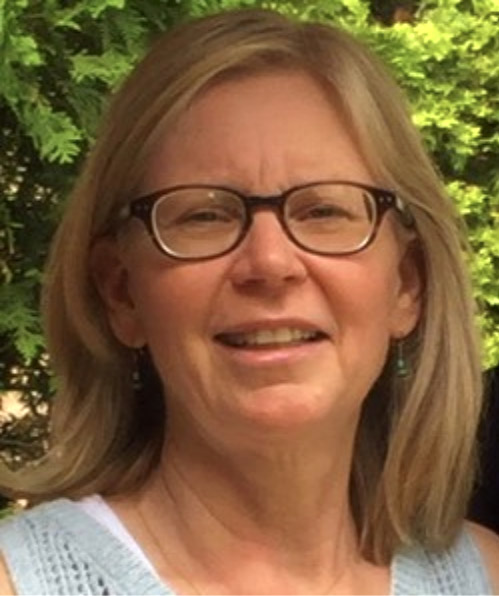
Cindy Fish (cfish@fishtrans.com) (she/her) President/Principal, Fish Transportation Group, Inc.
Role: Truck count consultant, camera installer, and expert thought partner.
Leading FTG’s transportation planning projects, Cindy has a vast portfolio of projects balancing mobility solutions for all modes and travelers of all ages and abilities. Her work is focused on enhancing safety and accessibility based in a complete streets and safe systems approach that considers shared mobility uses, curb use management, best practices, and innovative approaches.

José Acosta-Córdova (jacosta@lvejo.org) (he/him/el)Transportation Justice Program Manager, LVEJO
Role: EJ & freight expert, data analysis, and lead researcher.
José leads the Transportation & Mobility Justice program at LVEJO, which works on issues related to freight, EJ, and mobility justice at the local, state, and national levels. He is also the co-chair of the Transportation Equity Network (TEN) in Chicago. He is currently a Ph.D. candidate in Geography & GIS at the University of Illinois, and his dissertation is focused on the negative impacts of freight on EJ communities in Chicago, how freight has transformed since the deindustrialization period, as well as the role of low-wage labor in the growth of the warehousing boom in the Chicago metropolitan area. He was raised by social justice activists, and has been around the EJ movement since he was 3 years old.

Paulina Vaca (pvaca@cnt.org) (she/her)Project Associate, Urban Resilience, CNT
Role: Lead coordinator, internal project manager, and copywriter/editor.
Paulina is a young urban sustainability professional, intersectional environmentalist, and qualitative researcher. Her research includes a 2023 publication in the Journal of Agriculture, Food Systems, and Community Development, the world's only peer-reviewed transdisciplinary journal on food systems.
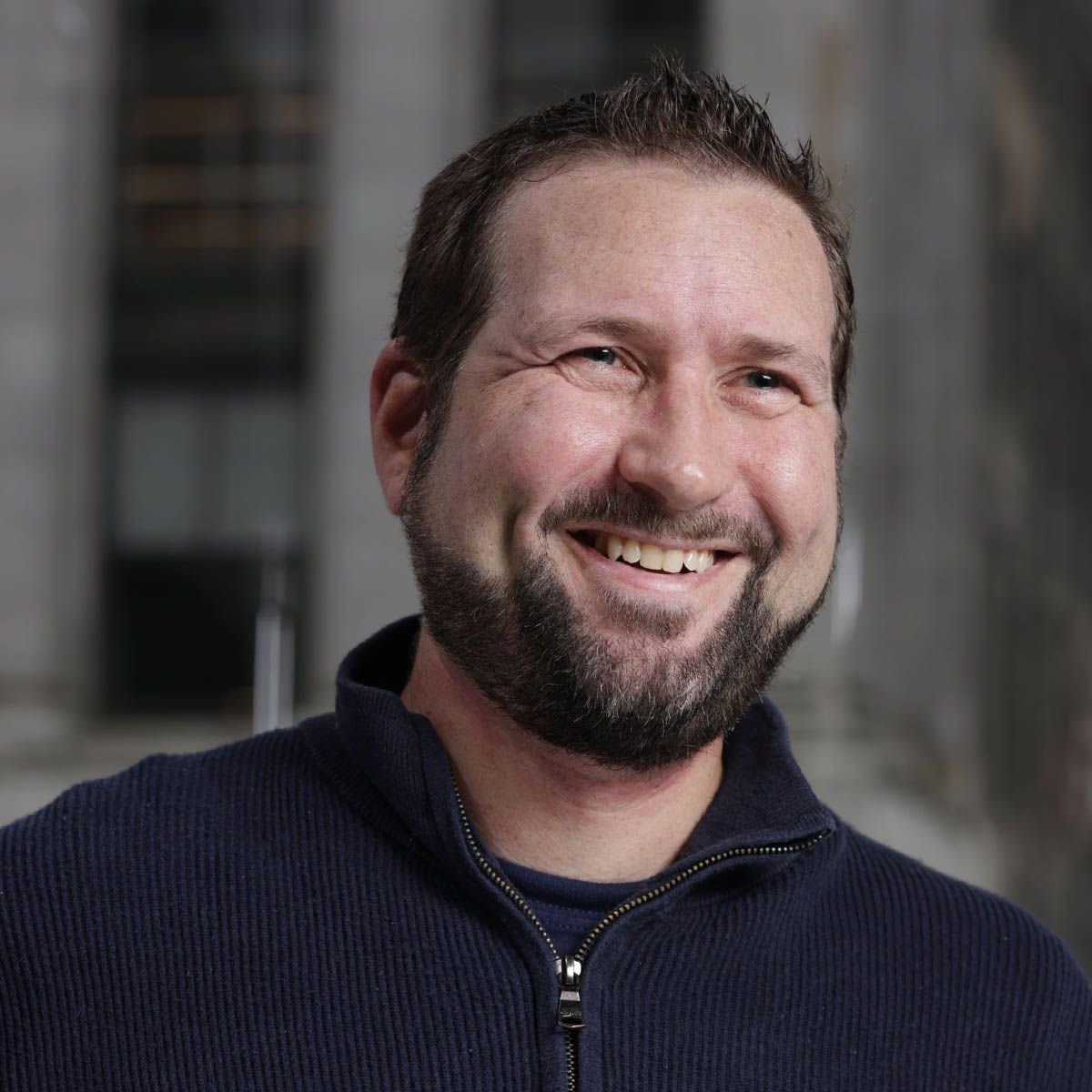
Jon Kuta (jkuta@cnt.org) (he/him)Senior Web Developer, Urban Analytics, CNT
Role: Web design and development.
Jon leads the planning, design and development of websites and interactive tools that advance a variety of initiatives of CNT and its partners. With an eye for design, Jon specializes in visualizing complex data and translating CNT's highly technical research into approachable and beautifully designed websites.
